Here we go again. My email and Twitter feed is being bombarded this morning by action alerts imploring me to contact my Senators in Washington to have them protect federal funding for bike projects.
The target by several Republicans is once again the Transportation Enhancements program. The TE program is seen as a crucial source of dedicated funds by national bike advocates. It has a proud track record of funding some of the most popular shared-use paths and trails around the country (including the Banks-Vernonia Trail that I posted about earlier this morning).
The latest threat to these funds is coming from Senator Rand Paul (R-KY). He wants to place an amendment in the upcoming transportation appropriations bill that would shift all funding in the TE program over to bridge repair. Sen. Paul’s idea is woefully misguided for many reasons and it’s clear that this is much more about politics and making headlines than it is about good transportation policy.
Sen. Paul is using his general dislike of investment in bicycling to make the case that our nation’s bridges are in such disrepair that they desperately need the tiny amount of money in the TE fund (which is only 2% of the total federal transportation budget, not the 10% which is constantly being quoted by anti-bike Senators).
Indeed, there has been a lot of much-needed attention on America’s deficient bridges lately. T4America is a transportation advocacy group that’s simultaneously fighting attacks on TE while encouraging Washington to spend more on bridges.
But what’s missing from this debate, in my opinion, is that the more trips we switch to biking, the longer our bridges will last and the more people we’ll be able to get across them safely.
And, it just so happens, Portland has a real example of this concept.
With all this talk of bridges and funding, I think it’s a good time to recall a story we did in April 2010 about the impact bicycling has had on the Hawthorne Bridge. The story was based off an analysis by Portland Bureau of Transportation’s bike coordinator Roger Geller. Geller’s theory, which he backs up with statistics and analysis you can see below, is that the Hawthorne Bridge has been able to carry more people with less congestion and at lower infrastructure investment because of one major factor — bike traffic.
OK, pay attention…
Below are two slides from one of Geller’s presentations that tell this story. Each one is followed by his slide notes (emphasis mine):
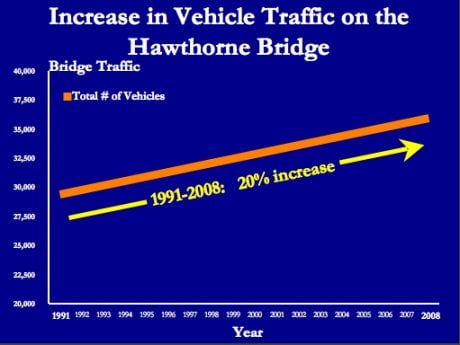
The total number of vehicles on the Hawthorne Bridge has increased 20% since 1991…This increased demand for mobility is consistent with what most traffic models would predict, given increases in population and increased economic activity. This type of increased demand for mobility can spell problems for road users: more congestion, more delay and less travel reliability.
But….
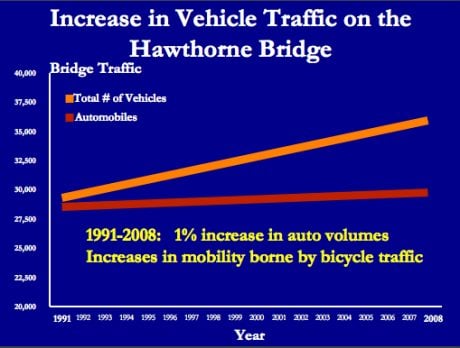
In the case of the Hawthorne Bridge, the negative effects of congestion have been kept at bay. Because, while the number of vehicles increased 20% between 1991 and
19982008, that increase has been almost wholly in bicycle traffic. Had the increase been—as it might be in most places—automobiles, then the intersections at either ends of the bridge would likely have failed in their ability to effectively and efficiently move traffic.The engineering solution to this type of congestion would have been to widen the intersections, add more travel lanes to the bridge, add more green time to the movements onto the bridge. In reality, because there are scant funds for such improvements, nothing would have been done and the costs would have been those of increased congestion.
However, because the increased demand for mobility has been borne almost exclusively by the bicycle, automotive traffic flows in this area the same today as it did in 1991. It is for this reason, in part, that Portland’s award winning traffic engineer, Rob Burchfield, states that: “Bicycling infrastructure is relatively easy to implement and low cost compared to other modes. It is by far the most cost-effective way to provide for personal mobility in an urban transportation system.”
While we obviously need to spend more money on bridge repair and maintenance in America, it’s important to keep an open mind for solutions that don’t require simply pouring hundreds of millions of dollars into them. As the Hawthorne Bridge example shows, in some cases, bridges can be “saved” simply by making them more accessible by people on bike and on foot.

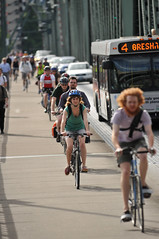
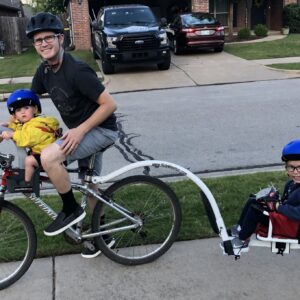
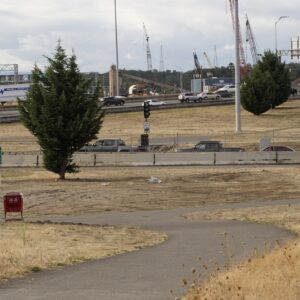
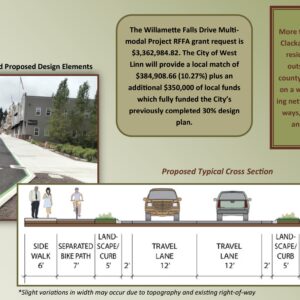
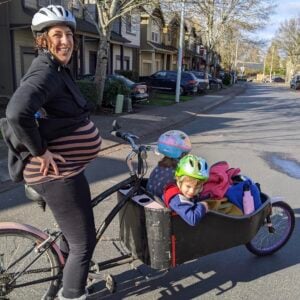
Beautifully argued, Roger and Jonathan!
This is precisely why we need to eliminate the federal transportation funding structure. Eliminate the federal gas tax and all general funds that support federal transportation spending, and allow the states to tax and spend on transportation as they see fit. We shouldn’t have to deal with nutjobs from Kentucky if we want to build bike paths in Oregon.
State DOTs can do what they want with state gas taxes.
Yes, we can. But a significant portion of the money we spend on transportation in the state is affected by federal funding and policies. Wouldn’t you rather ODOT have 100% of the control over transportation spending allocation?
I really wish Coburn would stop flipflopping on this, especially last time this happened when there was almost an Occupy Coburn’s Office in Tulsa over this…
Jonathan’s article, is once again spot on. However, Sen. Paul’s dislike for TE, and bicycle projects is not because he believes them to harm highway transportation projects at all. It is rooted in how much support they receive from the big oil interests, and the automobile industrial complex. It’s common sense that bicycling is excellent for cities, for human beings and better for local business. The problem, is that bicycling is bad for big oil, and automobile manufacturing corporations.
Take corporate money out of government policy, and the Rand Paul’s of the world fade into non-relevance.
Transportation Enhancements (TE) funds that fund biking and walking safety are such a tiny sliver of federal funding (~1.5%), that diverting them would do very little to address the problem of structurally deficient bridges.
If Sen. Rand Paul’s state of Kentucky dedicated all the federal funding they put into new highway capacity into fixing structurally deficient bridges instead, they could fix all of their bridges in about 6 years. Diverting TE funds to that effort would enable them to get it done only 6 months earlier – at great expense to the safety of people walking and biking.
Johnathan,
Excellent arguments and examples. Unfortunate, Senate Republicans need “fuzzy” math, not real numbers to base their decisions on!
Must be an election soon. Rand Paul talks about the problems of government doing this or that, but here he is wanting more government for bridges? But at the end of the day he’s Kentucky’s deal, and as mentioned, we shouldn’t be so dependent on on the Feds anyway.
Jonathan…your text needs a bit a tweek – there has been an increase in all traffic (bikes are traffic) and the bridge has been able to accomodate it due to most of this growth being bike traffic.
“Geller’s theory, … is that the Hawthorne Bridge has been able to carry more [remove: people with less] traffic and at lower costs in infrastructure investment because of one major factor — [the large increase in] bike traffic”
Another example of Jonathan Maus taking the behavior of 3-6% of the population and calling it a reason to have car drivers to either change to riding bikes on the Sellwood bridge or die as the bridge collapses due to a lack of funding for repair and replacement.
Not everyone wants to ride bikes to work, in fact 94-97% of the population in Portland don’t want to ride to work. Sure they care about the safety when they ride the waterfront on the weekends, or their bike to a Timber’s match, but a lot of us are more concerned about failing existing infrastructure for our cars.
The bridges falling down and public transit systems under great financial strain does not equal everyone can now ride a bike.
The existing infrastructure must be fixxxed.
Those bridges would never have been built, for Cyclists to take on as their own, without the automobile.
IF I seem a bit grumpy it is because my U-lock is stuck in the back pocket of my skinny jeans and my butt hurts as a result of that sitting here typing at Stumptown.
Sent from my iPad
Harvey,
Your anger and hate is clouding your comprehension of my statements (your mean last sentence is completely uncalled for). I never said we shouldn’t repair/fix/invest in bridges… I’m simply saying that we can squeeze more value out of existing infrastructure by getting more serious about promoting bicycling and making it a more viable option.
What if we altered the funding formula for bridge repair, holding off on fixing some of the more stable ones (essentially raising the threshold where repairs and fixes would be triggered) and then used those funds to improve bike access?
A bit much calling it hate, just because it is a perspective that doesn’t match yours.
Many could call your statements hateful with regards to how you deal with cars/drivers in your articles.
I could see the humor of the last statement, but I guess I’m more open to others views than you are.
Your beef should be with the transportation planning that have continuously chosen to expand highways rather than fix existing ones. Bike infrastructure is dirt cheap compared to auto infrastructure, and ongoing maintenance is also much lower. I think Jonathan’s point is that we shouldn’t have to sacrifice infrastructure for healthy, active transportation because planners have chosen to neglect existing bridges.
Energy prices will increase in the future. Doesn’t it seem silly to cut funding for viable alternatives? We’ve hit and iceberg, and the ship is taking on water. Rand Paul is asking us to sell the life boats so we can expand the ship.
The point here is that TE dollars can actually promote bridge health, without being spent directly on bridges. See? Not mutually exclusive! Funding for cycling and walking PRESERVES the infrastructure such that you are less likely to fall into the river (that being said that blasted Sellwood Br needs to be condemned, already).
There are better places to reallocate funds from than TE.
And I doubt the [dwindling, soon to be hotly contested] oil reserves really care whether you want to ride a bike or not, but feel free to write angry blog posts to them. Let us know how that goes.
Everybody is afraid of losing funding for their projects with Obama running this country into the ground. Housing starts at only 300,00, which is nothing. Running non-union business’s out of the country, gas doubled under his watch. Cyclists should be afraid of not getting money for needed improvements.
Just wait till Obama throws another bailout at a big bank or car company. It’s coming. This is change we can believe in for sure.
Trust me, you don’t want that. Even in bike-mad Oregon, it’s more likely to get spent on interchanges for big box strip centers, etc. — thanks to politically connected developers, and other sources of big campaign checks. Bike-ped projects can’t compete with that. Dedicated bike-ped funding is the only way to ensure we have any at all.
Mia Birk in her talk in Charlottesville last week kept telling the audience about her Portland projects, “Oh, by the way, that was paid for by TE.”
Please write your senators TODAY. Ours, in Virginia, are already onboard.